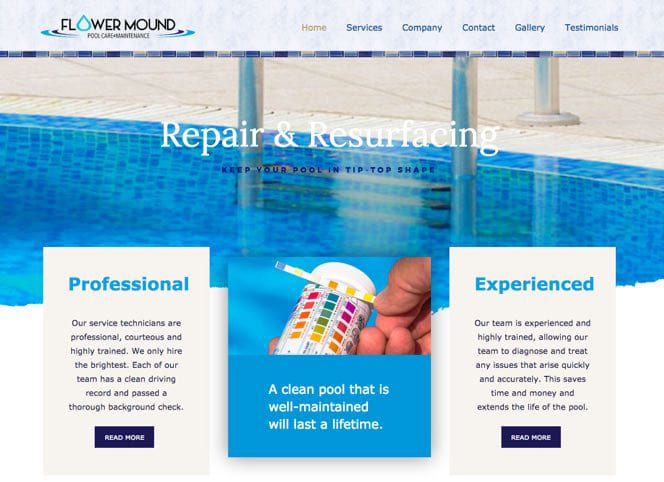If you build your own website or hire professionals, web design tips can help you get the most bang for your design buck.
Web design is anything but simple. One source tells you that simplistic is best, others say that intricate content-rich designs are the best—it’s impossible to know what’s right for you. Only you can determine that. What we can do is provide some of the best tips from every corner of the internet. Incorporating these into your web design plan is going to prove more effective than you may initially realize.
25. Text Contrast
Some website designs are difficult to view. The contract between text and the color of their background matters. If nobody can read your content, how are they going to know what you’re all about? Relying on view-able media is great, but not everything can be in video or audio format.
24. The Future is Wearable
VR, Pebble—the future of technology and IoT devices are wearable. It started with mobile, and devices are becoming hands-free. Get ahead of the curve; don’t hang behind. Integrate your websites ahead of time.
23. Social Media Matters
When you see it daily in the news, you understand the gravity—social media will evolve, but never die out. It’s only gaining momentum with each passing minute, and it’s crucial to incorporate into your website. When users can post your articles and products to their social media with the click of a button, you’re garnering free marketing. Nothing is better for your brand than personal advocacy from one friend to another.
22. Activity
Dead web pages rarely garner views, unless it’s what’s referred to as evergreen content. Your content is going to reflect your business, and as we all know, business morphs and evolves with every passing day. Staying up-to-date on trends, as well as remaining active with posts and site updates, are going to ensure that you’re left sitting pretty.
21. Trust
Look around you. How many products near you do you trust? Considering that you’ve purchased all of them, we’re going to wager that it’s 100%. It’s the same with websites. People aren’t going to spend time or engage a brand or message that they don’t trust. Make it personal, and fulfill promises to the viewers/customers.
20. Call to Action
We’ve all seen them everywhere—“Leave us a comment,” or “request a quote,” are just a couple of examples. It’s called a call to action, and it’s the request at the end of your post or bottom of your page to engage readers that will also build on your business. It’s different than social media integration. The goal of a proper call to action is to get customers or affiliate clicks; those who engage with the site itself, not just the comment box.
19. The Hub
Your homepage is rarely going to change, save for some plugins, and that’s okay. Your concise message needs to be displayed seamlessly with your design, and should never be too long. People want to get the feel for your website’s purpose quickly.
18. Five Seconds
Users flip through media and websites constantly. You have a grand total of five seconds to properly convey your message, and engage your readers, otherwise, they’re lost to you.
17. Better Website, Better Business
Nobody wants to spend time on a page that’s all design, and no content. It’s easy to forget your website’s initial purpose when we’re trying to streamline the design, but the apex of a good website (design + content + SEO) is going to bring in conversions. You can bench on design alone.
16. All Websites Contain Marketing
Save for strictly educational non-profit websites, there’s marketing absolutely everywhere, and your website is part of that marketing chain. Spending time on your website is crucial to maintaining your brand, as well as keeping visitors coming back. Webpages that just sit there end up getting lost in the millions of unvisited pages on the internet.
15. Pages Beat Sites
Your web pages rank; not your website as a whole. Each page matters, it’s not just about the whole picture. This is why you’ll see some articles or media blow up in terms of visits and views, while other portions of your site aren’t doing so hot. Your pages rank.
14. There Is No “Set and Forget”
You need to monitor how you site is doing, especially if you want to increase visits and lower your bounce rates. If your viewers are leaving the site way before you want them to, consider what you’re showcasing to them, and how Monitor your analytics. Keywords, conversions, and everything in between.
13. Ever Heard of Niche?
The biggest mistake you can make is assuming that you can handle the entire global market’s attention. It’s an impossible feat, and you shouldn’t waste your time doing that. Focus on those who are actually looking for your services or media. Every audience differs, because no two audiences are the same.
12. Desktop Isn’t Dead… Yet
Before the rise of the smartphone (and, consequentially, the tablet and SmartTV,) everything was done on desktop. More and more users are browsing the internet on their handheld devices. Those of us who are actually on our laptops or desktop computers are usually working, or viewing media that was otherwise unavailable on mobile. Be friendly to every type of design; phone, tablet, desktop.
11. Experience and Educational Sharing
When you reserve the information you’ve learned, or the experience you’ve accumulated, you’re showcasing to others that you’re not willing to assist and inform others. It just doesn’t look good—leading your industry means sharing your experience in a pubic forum. Don’t worry about your competitors grabbing that information; nobody utilizes it like you do.
10. Clear Skies
Your visitors shouldn’t have to narrow their eyes just because of your design. It needs to be easy to read, clear, concise, and to the point. Posting your site in tiny font—despite the users ability to zoom and increase—is just a bad idea. You’ll see a higher bounce rate than you will engagement.
9. Ignore Flash
Adobe is actually retiring flash. Mobile internet use (especially on Apple iOS) is becoming more utilized than desktop and laptop internet access. Flash websites are a waste of your time, especially when the kings of operating systems are abandoning it entirely. HTLM5 has taken over, and it’s a good thing.
8. The Anti-Scroll
We’ve all encountered this: one really long, singular page that drags on forever. Endless scrolling. Nix that, and make your page compact—while still remaining visible (so that your users don’t have to squint to see the content)—and your users will thank you for it… mostly by not bouncing to another page.
7. SEO Will Always Be King
80%+ of all internet users exclusive utilize Google as their search engine. Roughly 7% of those Google users won’t look past the first page of results. Can you see how important SEO is? So long as Google remains king of the internet, SEO will be the most important aspect of your business visibility.
6. Website Security
It sound remedial; you know that cybersecurity is a big issue. If you’re selling anything directly through your site, even if it’s through an ecommerce third-party program embedded on your site, you’re handling sensitive information that’s detrimental to your entire brand. There is no such thing as too much website security—just look at the 2017 Equifax breach.
5. Fall Behind, Fall Apart
Your competitors watch your site, believe it or not. You need to lead the industry; not watch it pass you by. If you don’t stay on top of your website design and keep it functional, and up to date, you’ll fall behind the second-rate companies and services in your industry. Don’t become part of the static.
4. Use The Tools That Are Available To You
Don’t bother trying to recreate everything that’s readily available to you. Use site building tools to get the right feel, such as WordPress, and don’t try to reinvent the wheel.
3. Visual Media
Most notably with the rise of YouTube, we’ve seen everyone put out videos for their business, and for good reason—it works. More and more visual media is being crafted to be viewed, not read. While articles are important, a three-minute introduction video on the homepage of a website can work wonders for establishing your brand, and your point.
2. Brand Portrayal
The internet used to be there to display your website, your company, but it’s evolved, just as any business does. It’s about what the user is looking for, not necessarily about your company. If you don’t immediately match the needs of the user, you’re not living up to your end of the bargain. They visited your website—what are they getting out of it?
1. Don’t Think About It
Good design means proper navigation without sacrificing all of your time. Users should be immediately immersed by the simplicity in the function, and the beauty of the design, both at the perfect apex of ease of access and a straightforward appeal. Don’t overthink it; your visitors shouldn’t have to, either.
We’re all about proper web design, content, and the details that make a difference.
For the very best implementation of killer web design and phenomenal content—much like the article you just read—call Portside Marketing at (972) 979-9316 for more information. Find out what our web design and content creation services can do for you. We have a lot more web design tips!!




